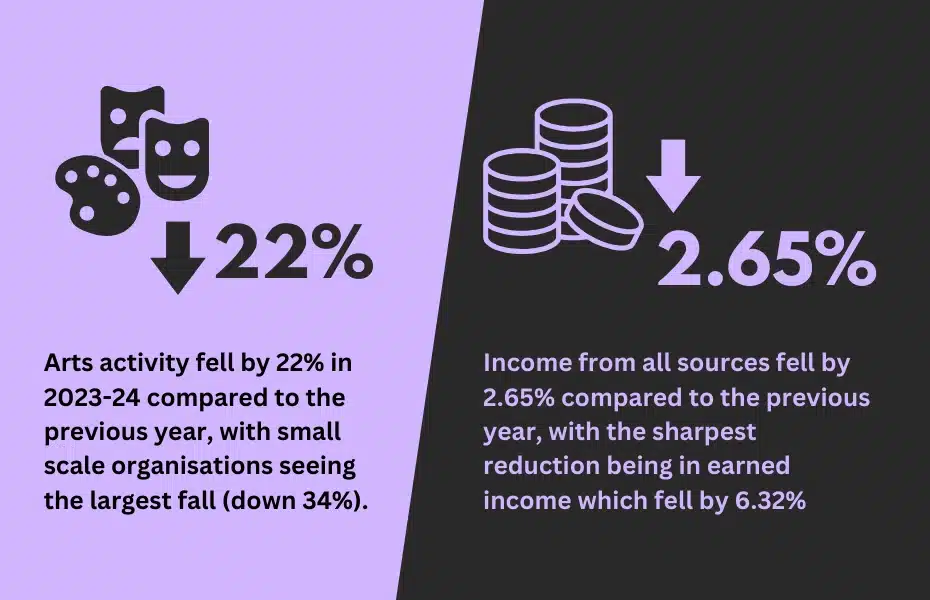Number of NI arts events falls year-on-year as impact of financial pressures hit creative sector
A survey released by the Arts Council of Northern Ireland reveals the impact the cost-of-living crisis, combined with a reduction in income is having on the arts sector, with 22% fewer performances, exhibitions and events held last year.
The findings from the Arts Council of Northern Ireland’s Annual Funding Survey* show that organisations are unable to offer the same level of arts programming compared to the previous 12 months, as costs rise and income falls.
The report compiles information from 84 small, medium and large-scale arts organisations who receive annual funding from the ACNI’s Annual Funding Programme and analyses data collected in the 2023-24 financial year. The annual survey looks at a number of areas, including employment, income and expenditure, programming, audiences and engagement.
Rising rent, rates, salaries and wider operating costs are set against a backdrop of limited available public funding for the arts. While many organisations have successfully secured funding from other public sector sources in the UK, ROI, as well as trusts and foundations (increase of 13%), this is not enough to fully offset rising costs.
Whilst the overall size of the workforce has remained the same, there has been a marked increase in the number of people employed in freelance and part-time positions, and an increase in the number of volunteers helping funded organisations deliver work (+10%)
Javier Stanziola , Acting Director of Strategic Development and Partnerships, at the Arts Council commented:
“The Annual Funding Survey is one of the most important sources of data we have in the arts sector in NI. It is a set of official statistics that provides valuable insights into some of the arts organisations we invest in, looking at their programming, employment, investment and income generation.
“This year’s data builds on the information gathered last year and provides a picture of a financially fragile arts sector. The funding these organisations receive from the Arts Council makes up around 23% of their overall income but unfortunately, despite successfully securing other additional investment, they are not able to take on the same number of full-time staff or produce the same amount of shows, workshops, or events.
“Funding from the Arts Council has stagnated, and additional investment is now required to bring us back to pre-pandemic levels. We know this funding is crucial to support efforts by arts organisations to attract and generate income from other sources. Public investment in the arts would not just increase funding from other sources, but would also benefit Northern Ireland society as a whole – creating jobs, benefiting communities and helping to attract future inward investment.”
Key Findings
Workforce
- Whilst the number of people working in these arts organisations has remained broadly the same, the proportion of those employed in part-time contract/freelance roles continues to grow, largely at the expense of those employed on a full-time contract or freelance basis. This puts into question the sustainability of the sector and its increasing reliance on precarious freelance workers.
- The sector is heavily reliant on formalised and informalised volunteering to support its operations, people working for free to support organisation development and enhance customer experiences. Medium scale organisations seem particularly reliant on this part of the workforce, with 81% of organisations engaging their services.
Finance
- Income from all sources fell by 2.65% compared to the previous year, with the sharpest reduction being in earned income which fell by 6.32%. Box-office income grew by only 3%.
- Expenditure fell by 4% year-on-year, with the proportion being spent on programming costs falling by 8.82%. This reduction is reflected in reduced activity levels and highlights how income is being diverted to support core funning costs rather than being invested in production and creative development.
- In terms of public sector income organisations seem to increasingly draw on other UK and RoI sources.
Activity
- Despite high public engagement with the arts, especially post-pandemic, provision has contracted and remains fragile.
- The number of activities or events delivered increased since the pandemic but fell by 22% between 2022-23 and 2023-24. This was the case across all organisation sizes, with the greatest fall recorded by small scale organisations (down 34%).
- The reduction in activity was absorbed by organisations delivering performances which fell by 27% and participation-based events, down 23%, when compared to the previous year. Other forms of activity including exhibitions and festivals saw their share of activity grow.
- The reduction in activity was reflected in levels of engagement, which fell by 10%.
- All funded organisations continue to target a proportion of their work at one or more marginalised group in Northern Ireland including disabled people, deprived neighbourhoods and supporting people with poor mental health/wellbeing. Small scale organisations were most likely to target their work at these groups
- The cost of delivery continues to supress the provision of disability access support to venues, although a third of organisations now provide an induction loop, some, most or all of the time.
International working
- Nearly three quarters of organisations continue to undertake international activity as part of their annual programmes, with the majority of collaboration taking place with creatives and organisations based either on the island of Ireland or GB. Of note was the reduction in engagement with creatives, audiences and organisations based within the EU.
- These findings complement the small but growing proportion of earned income being generated from international touring in 2023-24, with touring destinations including Australia, India and Africa.
